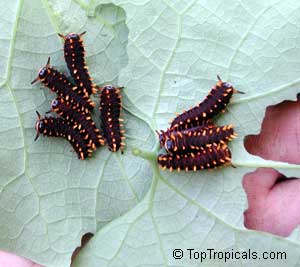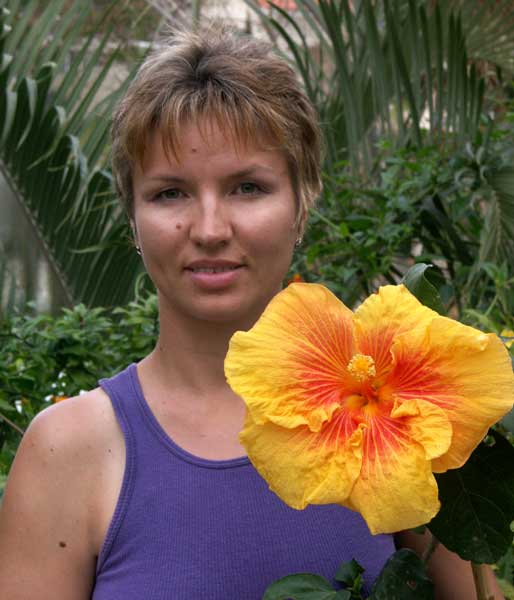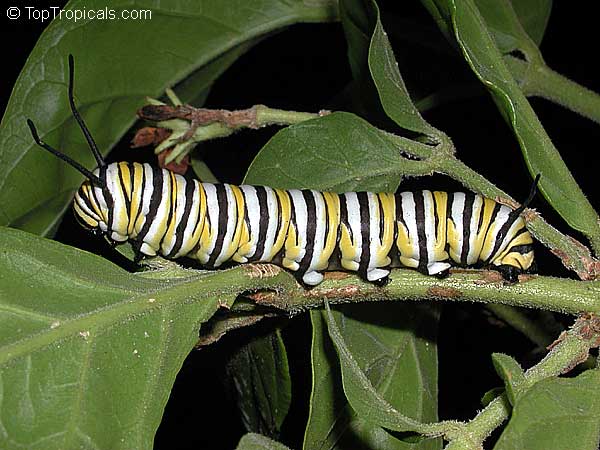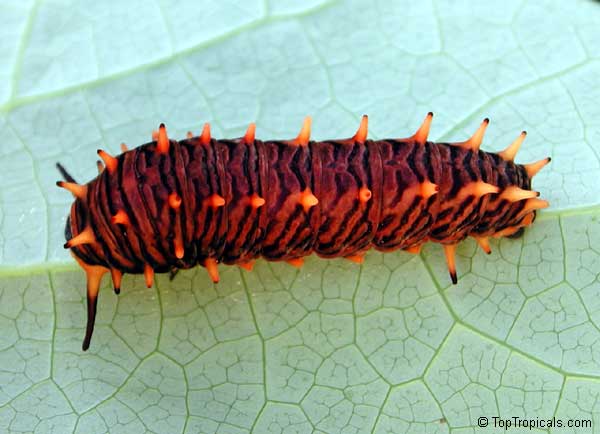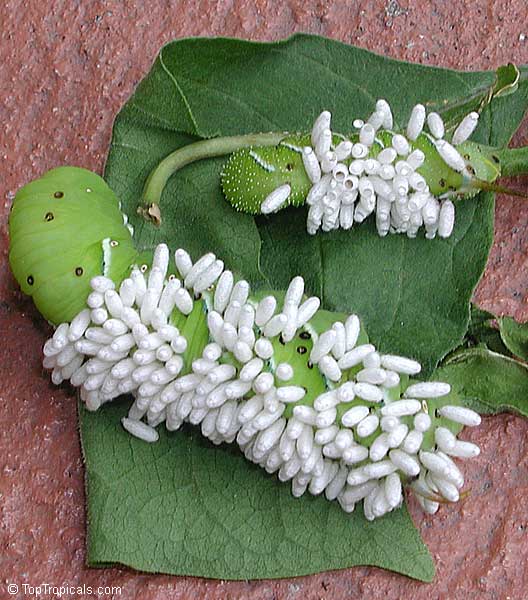Troubleshooting
Problem solving with potted plants - how can we help them?
Click on image to enlarge
Plants are live creatures, they eat, drink, breath and multiply... get sick and die. They are not immortal, but in many cases something can be done to get them better and help to survive a stress or overcome a disease. The question is - what needs to be done? Unfortunately, plants won't talk and are unable to tell us what hurts. But they have a sign language that every experienced gardener will learn with time.
When the plant is getting worse with every hour, it hurts our heart. You must realize that you are the only doctor assigned to this patient and it's health and life is now in your hands. Do not panic and do not perform any unreasoned actions. Seek for advice if not sure. Get a book, search online. Ask your friend who had the same problem. And be wise and patient: plants are not as fast as animals, they usually don't die overnight, so you have some time for research and right steps.
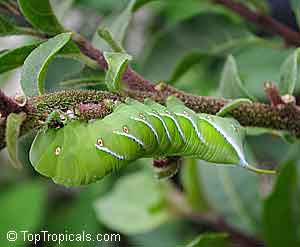
- Step number 1: Place the plant in a shade. Direct light may kill even a sun-lover if it is sick.
- Step number 2: Stop watering (unless the soil is dry)
- Step number 3: No fertilizer. If there is any unused granulated fertilizer, carefully remove as much as you can without damaging roots.
- Step number 4: Check for insects and fungus. If this is not a case, continue with next step.
- Step number 5: Increase humidity. All tropical plants (excluding some desert tropicals) enjoy humid air. Spray with clean water and put a clear plastic bag over the plant, leaving stem base and soil open.
Now that you've done the First Aid Emergency Care, try to diagnose.
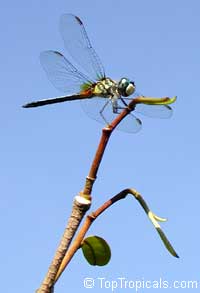
Pre-diagnostics
First of all, you must realize that there is no panacea or ideal remedy. Like human, every individual plant has its own unique body and specifics, so the same species from the same nursery in the same conditions can act differently. A gardener is like a doctor who is trying to figure out the problem step by step, excluding one possible disease by another. Sometimes even experienced gardener fails to make a plant thrive, and the "patient" dies after all the efforts... However, knowing the basics of plants "likes" and "dislikes" will help you to avoid mistakes and save many "babies".
Secondly, even experienced gardeners make mistakes: miss watering, or over-water, or accidentally add too much fertilizer, forget to spray pests in time... Missing important procedure may lead to a beginning of the "end". If you notice the problem in time, it's not too late to fix it.
It's important to mention that many of you grow tropical plants in non-tropical climates, sometimes indoors. For a tropical plant, this might be an unsuitable environment, with lack of light and humidity, without natural predators that can take care of unwanted bugs.
Some plants we buy mail-order are grown in greenhouses up North, and those babies are completely different story, their immune system can be weak to cope with stresses, their disease resistance is very low. Those plants are like unhealthy people imprisoned within a rock building with AC, with no fresh air, fed with canned food and drugs... We'll talk about those plants in a separate class, and now we assume that the sick plant was field grown, and was originally healthy.
Remember, to prevent possible problems is much easier than to treat them.

Milkweed (Asclepias) is a favorite food not only for butterflies, but also for common aphids
When your plants arrive from a mail-order source
- leave them alone for a few days, don't push your care!
This doesn't mean you shouldn't unpack the box though. Carefully open the package as soon as possible, and follow general instructions that came with the plants. After you settled them into pots (if they arrived without pots) with the right soil, watered and misted the leaves, line them up, look at them with admiration and enjoy your job, and then place them in a shaded warm spot for a few days. NO fertilizer at this time! Let them cope with the shipping stress and adjust to new conditions (humidity, bright light after being in a dark box), your pushing "care" may become an extra burden for them. Check soil with your finger every day and water only when you feel it's dry.
If the plant has yellow, dry leaves or even if it dropped all the leaves - there is no reason yet to panic. It happens to over 50% of shipped plants. A good idea will be to place a clear plastic bag over the crown (see picture), with stem and soil open to air circulation. Misting the leaves prior to bagging is beneficial. In most cases, if kept under plastic for 1-2 weeks, the plant will start sprouting new growth. Make sure the spot is well-lit. No direct sun (it will cook the plant in the bag!), but the light must be bright enough. A windowsill with eastern or northern exposure will do. Large tree canopy is the best if you live in a warm climate (temperature must be between 70F and 85F).
This bauhinia arrived from Hawaii bareroot (roots wrapped in damp paper towel). Regardless humid Florida air, we still placed it under plastic, and the plant made it. In 4 weeks plastic was removed and new leaves covered the plants.
Adjusting. If you received a new plant, don't plant it in ground or re-pot right away, unless you brought it from a next-door nursery. Place the pot either in shaded warm place (if the plant was shipped) or at the place where you want it to be planted, and see how it likes it there. Only after a few days of living at its new home the new comer is ready to be planted.
Re-potting. If you decide that the plant needs to be re-potted in bigger container, consider the size of a new pot. It shouldn't be much bigger than the original one. 3-4" difference in diameter is just fine. If you use too large container, there is a great risk to over-water. Roots need oxygen for healthy functioning. The oxygen is emerged by roots: this means, as a circle, in areas where there are no roots, there is a lack of oxygen, and the roots may rot.
Water well once, and next time water only if the top of soil gets a little dry. After transportation stress, plants "lose appetite" and do not "drink" as much water as they normally do. If watering exceeds plant's current needs, it's in danger of root rot.
Humidity and Misting. Try to mist the plant as often as you can. Remember that roots of a stressed plant stop "working" and pumping water, while the whole plant's body needs moisture. If you provide humidity around plant's crown, it will deliver moisture to leaves and branches, and chances to survive jump up. A good way to increase air humidity around the plant is to place the pot on a tray with pebbles and water so the pot stays dry, while water evaporates above the tray.
Light. After a while, when you notice that wilted leaves got healthy, elastic and juicy again, you may start gradually moving the plant into a place with brighter light.
Fertilizer. It is very important NOT to fertilize plants for a few (2-5) weeks after shipping and/or re-potting. If the plant was stressed or roots were damaged, fertilizer would burn the roots. Let the plant recover, adjust and establish. Only when you are sure that risk is over, start fertilizing with slow-release granules or spray foliage with 1/2 solution of water soluble fertilizer. Microelements mix solution or stress-relief hormones can be sprayed almost right away and shouldn't do any harm unless you overdo you care (be reasonable in quantities and frequency). In winter, no fertilizer necessary till spring except for microelements. In any case fertilizing by spraying on leaves is more safe than in-soil.
If all the above methods were tried, but the plant still looks sick, first you have to determine what exactly happened, without trying to water or fertilize it. Remember - under-watering (under-fertilizing) is always less dangerous than over-watering (over-fertilizing).
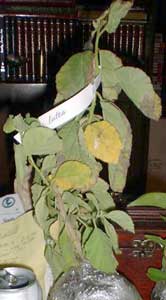
4/7/04
From Customers feedback:
...Jean received a wilted Cordia Lutea on April 7 and was very disappointed, she sent us a photo of the plant upon arrival. We suggested to give it some time to recover, and in 3 weeks we received a positive update from her with a new picture! Congratulations with your green thumb, Jean!..
"You had asked for an update on that Cordia lutea that I had ordered several weeks ago. It seems to be recovering well and looks like a happy little tree. I have attached a picture of it in the small pot in which it was planted (so as not to overwhelm the root system). It will be planted in a larger pot very soon.
Again, thank you!
Sincerely,
Jean Exnicios"
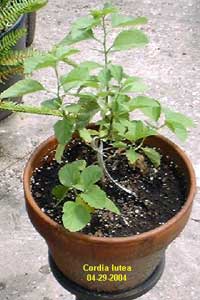
4/29/04
Possible problems
It takes experience to figure out the problem, since many symptoms look alike, while the reason could be different or even contrary.

When grown for shipping, plants can be kept in small containers for a long time - much longer than they are supposed to. It's understandable - we try to save on freight. In such conditions the rootball may become very tight. This causes 2 major problems:
- Nutrients deficiency
- Roots may become unable to develop sidewise even after repotting
When you received a plant from a nursery, the first thing you think of is a new container. It is important to chose a right pot, and of the same importance is to make sure the root system will develop properly.
If you simply plant a root-bounded clod into a bigger container, it might not make a difference for the plant, because the roots are compressed and winded around in a circle. They are clogged from developing and spreading.

The only way to make them grow sidewise is to create a new points of growth. This can be achieved by vertical cuts along the rootball with a sharp knife. With large plants (1-3 gal pot) you may go as deep as 1" inside the rootball. This procedure might seem violent, and my first cut was also cutting my heart. But believe me, the surgery result is worth the pain. Within a few weeks your plant will create a healthy developed root system. If you spare the ugly creature, it will stay the same for the rest of the life, and when you look at the roots in a few weeks, you will see that they stayed as a tangled ball and didn't make any move.
Be brave, doctor!
Many plants produced in quantities if overgrown their pots suffer chlorosis or lack of iron (Fe). What is chlorosis and how to treat it - see in our article about Microelements Mix. It is not dangerous, but plants look unattractive and slow down the growth.

Causes: Lack of microelements, root weakness, over-watering, root-bound,
tight pot
Symptoms: Leaves turn yellow or light green, sometimes off-white,
while the veins stay dark, and the leaf stays strong and elastic.
Treatment: Spray with microelements solution
containing iron chelate according to directions. The leaves usually turn darker
in just a few days (depends on level of the problem)
Sun burn when moved from shade to full sun
Causes: Excess light usually is not very dangerous unless you place a shade-loving or sick plant in full sun without gradual adjustment. However, it makes leaves look less attractive.
Symptoms: Leaves turn yellow or brown, look faded. Large-leaf species grow smaller leaves.
Treatment: Move the plant gradually in filtered light or place a cloth/net over it. On a windowsill you may use a sheet of paper or one-way mirror (reflecting) film on a window glass. If you move the plant that was exposed to full sun for a long time, into deep shade, it might drop leaves. Sunburns won't heal, you have to wait for the new growth.
Shade loving plant leaves yellowing in full sun
Leggy twigs of calliandra on a Northern windowsill
This is the second common problem after over-watering that happens very often when growing plants indoors.
Symptoms: The plant either stops growing or branches become leggy. Leaves turn dark green or grayish, sometimes wilted and dry, and usually larger and darker than regular ones for this species, but total amount of leaves is less than usual, canopy is not dense enough. The plant won't bloom. The top point of growth may die. No new buds. Leaves drop, sometimes still green. Soil stays wet for a long time, the plant feels no "thirst".
Treatment: Move the plant VERY gradually to a better lit spot. The longer the plant was kept in the shade, the more gradual the transformation should be. If you don't have a naturally bright spot, use additional artificial light.
Usually plants react well on light improvement. As soon as in couple weeks they will sprout new buds, roots start pumping water that will be noticed by quick soil drying.
This gardenia was killed by daily tropical rains.
Overwatering is the most common problem with potted plants. It is more dangerous than under-watering.
Rule number one: never water a plant if the soil is still damp. Watering skill comes with experience. Touch the soil with your finger, feel it. If in doubt - water with small portions, by 1-2 tablespoons.
Symptoms: Wilted, sometimes dry leaves. Unfortunately, over-watering symptoms look almost the same as under-watering. This is why amateur gardeners very often start watering over-watered plant even more, once they see it looks wilted. Leaves become "papery", thin, fade, very often turn yellow starting from lower branches. Tips of leaves may turn brown and dry.
Causes: In case of over-watering roots are damaged and atrophied (lack of oxygen, see above - repotting), as a result - dehydration of the whole plant, leaves and stems dry out.
Treatment: Stop watering. If the soil is wet, remove the root ball out of pot, toss off extra soil without disturbing roots, place the plant on paper towel and let dry (in shade!) - you may use a small fan for 10-15 min. Add more dry soil into the pot (not extra dry, but not soggy, it must be slightly damp). Put the pot in a warm well-lit spot, without direct sun. Mist the leaves and put a plastic bag over the crown (see photo above) to create humidity environment - treat it exactly as we spoke about transportation-stressed plant assuming the roots won't do their job. Make sure the soil surface and a base of a stem are well air curculated. Mist often and carefully so the water won't get on the stem base and on top of the soil.
Confusing: Over-watered? Increase humidity! See below - air humidity.
Overwatering is dangerous because very few plants can recover from this kind of trouble. Percentage of survivors is very low.
Use only well-drained potting mix.

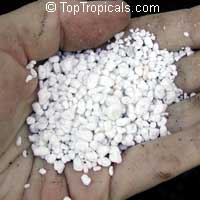
Important components for successful drainage: soil conditioner (pine bark) and perlite. Available from our store.
Usually this problem is easy to fix unless you managed to end up with a herbarium.
Symptoms: Unfortunately, they look very alike to over-watering symptoms. The difference is that the soil is extremely dry. Roots might stay healthy if it's not too late.
Treatment: Make sure this is the problem. Take the root ball
out of the pot and make sure it is completely dry. If the soil is damp
- your plant don't need water and this is definitely a different trouble.
When the potting mix is over-dried, especially if it contains a lot
of peat moss, it is very difficult to soak in again. It just takes a
while. Regular watering won't help: the water will drain through and
won't be retained. Place the pot in a bucket of water and wait until
it's drown to the bottom. If it's floating - the soil haven't absorbed
the water yet. When the soil is finally soaked, take the pot out of
the bucket and place on a lifted surface so the excess water drains
through. Next watering should be only when the upper soil gets slightly
dry. Usually if the roots are still alive, this procedure is enough.
Sometimes when saving over-dried plant that was in long transit (shipped
in a box), we also apply plastic bag over the crown.
If all leaves dried and dropped, but the stem is elastic and green (scratch
a bit with your fingernail), the plant should make it and will sprout
new buds in 1-2 weeks.


This Stephanotis took a trip of 34 days long!
...Our customer ordered it and left for a vacation, she completely forgot about her order! After she didn't pick up her package from the Post Office for a few weeks, it was returned to sender (us). We opened the box and of course we saw a dry stick. However, I gave it a chance, planted back in a pot and placed in shade, and forgot about it again, being sure it won't make it... We found this plant in 3 weeks with new leaves growing!..
Remember that you can not substitute humid air with wet feet. Do not confuse humidity with more frequent watering! It will kill the plant. When air is dry, over-watering kills. If a plant is over-watered, high humidity around the foliage can help to save it!

Low air humidity is another common problem along with over-watering. Most of tropical and subtropical plants enjoy it hot and humid. While you can't stay outside with humid heated air and tempt to get inside the AC building, the 'sauna' outside is just what the plants like.
Some tropical plants, especially those originated from rainforest, are very fussy about air humidity and won't grow if the air is too dry. You need special environment for them, like a greenhouse. But most of plants can adjust to dry air as long as humidity can be maintained around 50-60% (the higher the better). Only desert plants and selected easy tropicals (like some philodendrons, azaleas) can tolerate dry air.
Remember that Air Conditioning makes air very dry. If possible, do not keep tropical plants in air conditioned room. If AC room is you only option - at least never place a pot directly under AC air stream.
Symptoms: Leaves dry, deform, drop. New growth, buds and growing point dry off and die.

Treatment: Once you received a tropical plant, especially from tropical areas (like Florida, where we have 80-90% humidity) or/and if you know that this plant loves high humidity - you may cover the crown with a clear plastic bag right away. This is important in case the arrived plant looks tired and srtressed. Very gradually let it adjust to drier air by taking off the bag several times a day, then more often and for longer periods, until the plant adjusts completely. Do not pamper too much: if you notice leaves wilted, still leave the plant without a bag for 1-2 hours, then put the bag back on. By the end of this 'training' you may leave plastic on in the afternoon and take it off during night when evaporation is minimal. Misting helps a lot. Placing a pot on a tray with wet pebbles, too.
Note that frequent misting is only a part way to increase air humidity. If you have many crowded plants, air humidifier is a better solution.
The same technique should be applied to all weak and recently transplanted plants, especially if the root damage occurred. Increasing air humidity helps to survive the stress.
Fungus loves it wet, warm and dark
Fungus
This is a common problem in humid climate especially when plants are crowded without proper air circulation.
Symptoms: Dark spots (dots) on leaves. Sometimes extended areasare affected or the whole leaf.
Precautions: Do not mist/water your plants during evening or night hours, when evaporation and light is low. The best time for watering and spray - early morning (for more frequent misting - afternoon hours, too). Leaves must dry before they go to bed.
Treatment: Fungicide solution spray according to directions on the bottle. Copper is good. Make sure the solution doesn't get into the soil. Remove damaged leaves if possible.
Note that frequent misting is only part way to increase air humidity. If you have many crowded plants, air humidifier is a better solution.
Overdose of Boron (B) leaded to leaves curling.
Let us assume that you followed our advice and waited with fertilizing until a few weeks after your new plant arrived and got established. However you might get too generous or pushy and overdid the dose...
Symptoms: Leaves wilt, turn grayish, sometimes dry on tips and turn dark. The growing point dries and falls off. The plant stops growing. Overdosing with Nitrogen (N) during cool period is very dangerous since it can burn the roots.
Treatment: Take the root ball out of the pot and bareroot the plant: wash the soil off as much as possible with the least root damage. If safe bererooting is impossible, you may place the pot under running water for 10-20 min and then rinse it off with distilled water (available in the grocery store). Let the excess water drain through. Plant in a new fertilizer-free soil.
If the plant wasn't deadly poisoned with the chemicals, it should slowly recover. Usually recovering process takes a few weeks, sometimes months.
Note that over-fertilizing with microelements is almost impossible if you apply it in light solution over the foliage, and theoretically can be done quite often. However, do not pamper your plants too often. In case with any water soluble fertilizer or supplement, plants get used to this "fun" easily and simply stop developing root system if all nutrients are received in full through leaves absorbing. Do not make their life too easy if you want to raise winners!
Coffee leaves damaged with low temperatures

New growth on a tree
that caught cold
Most of tropical and subtropical plants stop growing process below 65F and can get cold damage below 45-50F, some ultra-tropical plants can be severely damaged or even killed with temperatures below 55F.
Note that the most important factor is not just a temperature value, but rather the duration of a cold period. Imagine yourself jogging with no T-shirt in winter for 5 minutes, or waiting for 2 hours for your date outside a movie theater even in a warm coat but with chilly wind. The longer the time period, the more dangerous to catch a cold.
Chilly winds are even more dangerous and can destroy a plant in a matter of minutes even if the air temperature doesn't seem to be critical. Protect your tropicals from chilly wind!
Symptoms: Leaves get dry, often by segments. Growing point dries off and dies. Chilblains can destroy a leaf immediately. (Put a piece of parsley in a freezer for a few minutes, then take it out and see what happens to the leaf in a few hours.
Treatment: Light cold damages usually won't kill the plant. Put in in a warm and well-lit place, away from heaters (so you don't overdry the leaves completely) and put a plastic bag over the crown. Reduce watering, since most likely the plant guessed it's winter time and time to sleep. Start regular watering only when new growth appears. If you don't see any new growth, but sure that the plant is alive (slightly scratch the stem to see if it's green inside), it might happen that the plant went dormant and doesn't want to trust you for a while that now it's safe to grow again. Be patient, give it some time and keep it on a low watering program until you see new buds.

Bixa is recovering from chilly wind damage and sprouting new growth.
Very often pests inhabit underneath the leaves and are difficult to notice, but they suck out juices which prevents normal plant growth.
This is a long talk. It's worth a separate article or even a book. Below is just a brief overview of the problem.
Remember that in natural environment bugs are the essential part of the Nature. Their affect to plants is balanced with a food chain of insect predators and other natural enemies. When you take a plant out of habitat, this chain is broken and with uncontrolled insects it can be eaten to death if unprotected.
We treat our plants for pests on regular basis with several professional chemicals. This way we keep insects away or on minimum level. Once the plant is away from regular insect protection plan, it becomes a target for all kinds of germs that fly around in the air, sometimes unnoticed. If you grow your plants in an isolated area (indoors or greenhouse) where natural enemies can't reach the "pray", there is a high risk of insect attack. The only way to control insects is to provide treatments on regular basis.

A little snail is hard to notice, but the damage can be severe
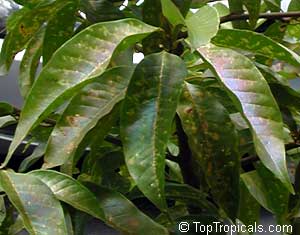
Damaged leaves of this Michelia were completely removed, and after treatment the plant started a new healthy growth.
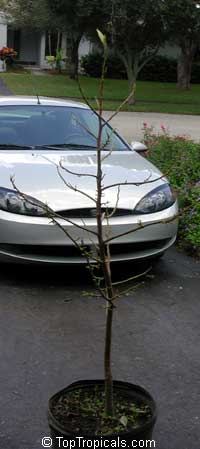
Note that a healthy plant has a strong immune system and high pest resistance. Bugs jump on a sick plant first. If you provide your plants with lots of light, balanced food and comfortable conditions, most likely it will stay healthy with a minimum preventive insect treatment.
Symptoms: Curling and deforming of leaves and new shoots. The plant stops growing. Leaves drop. Mechanical damage: holes, cuts, bites. Coatings, white or dark spots, films, nets can be traces of bugs, slugs, mites.
Precautions and treatment: Monitor leaves and underneath the leaves on regular basis. If noticed a pest problem, immediately take care of it. Isolate a sick plant from healthy ones. Remove damaged leaves and branches as possible, seal them in a plastic bag and and bury the bag on the bottom of your garbage can, or burn them. Rinse the plant well with a water stream. Make sure the rinsed disease won't get on healthy plants or grass (concrete basement of bathroom are good choices). Get a treatment from your local garden center and follow instructions.
Important: Always follow recommended concentration and treatment frequency. Stronger solution may burn the leaves, while light solution allows bugs to adapt to the chemical.
A Plant is a live creature.
When taken out of natural habitat, it becomes a helpless baby and needs
you care.
If you chose an exclusive fun of tropical gardening - you have to pay
with your patience and efforts.
Good luck!
Arostolochia lovers: a choice between fancy leaves and beautiful butterflies...
